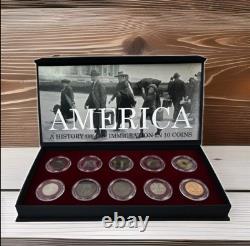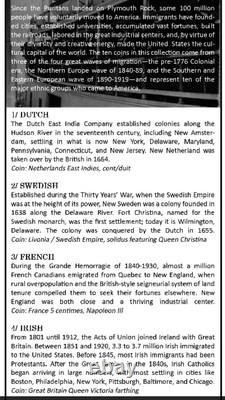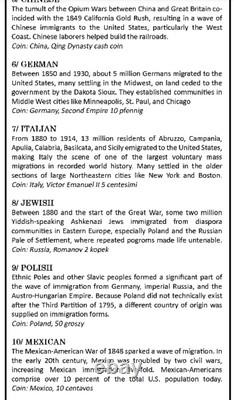
- Index
- Certification
- Composition
- .999 Silver (10)
- .9999 Silver (28)
- 99.99% Pure Silver (29)
- Aluminum (18)
- Bi-metallic (6)
- Billon (10)
- Bronze (54)
- Copper (12)
- Gold (37)
- Gold And Silver (9)
- Gold, Silver (8)
- Nickel (9)
- Pure Silver (14)
- Silver (3435)
- Silver .999 (5)
- Silver 925 / 1000 (13)
- Silver 999 / 1000 (8)
- Silver Certificate (7)
- Silver With Opal (5)
- Varies (6)
- ... (2014)
- Denomination
- Fineness
- Grade
- Year
America 250 Years of Immigration (10 Coin Boxed Collection)






America : 250 Years of Immigration (10 Coin Boxed Collection). Since the Puritans landed on Plymouth Rock, some 100 million people have voluntarily moved to America. Immigrants have founded cities, established universities, accumulated vast fortunes, built the railroads, labored in the great industrial centers, and, by virtue of their diversity and creative energy, made the United States the cultural capital of the world.
The Dutch East India Company established colonies along the Hudson River in the seventeenth century, including New Amster- dam, settling in what is now New York, Delaware, Maryland, Pennsylvania, Connecticut, and New Jersey. New Netherland was taken over by the British in 1664.
Coin: Netherlands East Indies, cent/duit. Established during the Thirty Years' War, when the Swedish Empire was at the height of its power, New Sweden was a colony founded in 1638 along the Delaware River. Fort Christina, named for the Swedish monarch, was the first settlement; today it is Wilmington, Delaware. The colony was conquered by the Dutch in 1655. Coin: Livonia/Swedish Empire, solidus featuring Queen Christina. New England was both close and a thriving industrial center.Coin: France 5 centimes, Napoleon Ill. From 1801 until 1912, the Acts of Union joined Ireland with Great Britain. Between 1851 and 1920, 3.3 to 3.7 million Irish immigrated to the United States. Before 1845, most Irish immigrants had been Protestants.
After the Great Famine in the 1840s, Irish Catholics began arriving in large numbers, with most settling in cities like Boston, Philadelphia, New York, Pittsburgh, Baltimore, and Chicago. Coin: Great Britain Queen Victoria farthing. The tumult of the Opium Wars between China and Great Britain co- incided with the 1849 California Gold Rush, resulting in a wave of Chinese immigrants to the United States, particularly the West Coast. Chinese laborers helped build the railroads. Coin: China, Qing Dynasty cash coin.Between 1850 and 1930, about 5 million Germans migrated to the United States, many settling in the Midwest, on land ceded to the government by the Dakota Sioux. They established communities in Middle West cities like Minneapolis, St. Paul, and Chicago Coin: Germany, Second Empire 10 pfennig. From 1880 to 1914, 13 million residents of Abruzzo, Campania, Apulia, Calabria, Basilcata, and Sicily emigrated to the United States, making Italy the scene of one of the largest voluntary mass migrations in recorded world history. Many settled in the older sections of large Northeastern cities like New York and Boston.
Coin: Italy, Victor Emanuel II 5 centesimi. Between 1880 and the start of the Great War, some two million Yiddish-speaking Ashkenazi Jews immigrated from diaspora communities in Eastern Europe, especially Poland and the Russian Pale of Settlement, where repeated pogroms made life untenable. Coin: Russia, Romanov 2 kopek.
Ethnic Poles and other Slavic peoples formed a significant part of the wave of immigration from Germany, imperial Russia, and the Austro-Hungarian Empire. Because Poland did not technically exist after the Third Partition of 1795, a different country of origin was supplied on immigration forms. The Mexican-American War of 1848 sparked a wave of migration. In the early 20th century, Mexico was troubled by two civil wars, increasing Mexican immigration five-fold. Mexican-Americans comprise over 10 percent of the total U.
